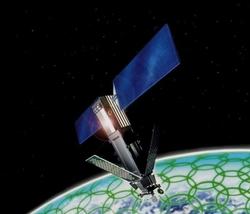Defunct Cosmos Probe, Iridium Satellite 'Ran Into Each
Other'
 On Tuesday, a defunct Russian
military satellite collided with an active Iridium communication
satellite in orbit, about 490 miles above northern Siberia... in
what is believed to be the first documented case of an accidental
satellite collision.
On Tuesday, a defunct Russian
military satellite collided with an active Iridium communication
satellite in orbit, about 490 miles above northern Siberia... in
what is believed to be the first documented case of an accidental
satellite collision.
Nicholas Johnson, the chief scientist for orbital debris at
NASA's Johnson Space Center in Houston, told CBS News surveillance
networks are tracking a large cloud of debris from the impact, and
it's unclear whether those pieces may pose problems for other
on-orbit satellites.
"As of about 12 hours ago, I think the head count was up (to
around) 600 pieces," added Air Force Brig. Gen. Michael Carey,
deputy director of global operations at US Strategic Command. "It's
going to take about two days before we get a solid picture of what
the debris fields look like. But you, I think, can imply that the
majority of that should be probably along the same line as the
original orbits."
Carey identified the Russian satellite as Cosmos 2251, a
communications relay station launched in 1993 and believed to have
been offline for around 10 years. "Nothing to this extent (has
happened before)," he said. "We've had three other accidental
collisions between what we call catalog objects, but they were all
much smaller than this and always a moderate sized objects and a
very small object. And these are two relatively big objects. So
this is a first, unfortunately."
While NASA is fairly sure the International Space Station has
little to fear from the collision, Johnson said it will take awhile
to know what further dangers the debris may pose.
"There are two issues: the immediate threat and a longer-term
threat," he said. "It turns out, when you have a collision like
this the debris is thrown very energetically both to higher orbits
and to lower orbits. So there are actually debris from this event
which we believe are going through the space station's altitude
already. Most of it is not, most of it is still clustered up where
the event took place. But a small number are going through
station's altitude," around 220 miles above Earth.
 Iridium issued a terse statement
Wednesday about the loss of one of its satellites, stressing the
even had "minimal impact" on the company's service. "...The company
is taking immediate action to address the loss," Iridium stated.
"The Iridium constellation is healthy, and this event is not the
result of a failure on the part of Iridium or its technology. While
this is an extremely unusual, very low-probability event, the
Iridium constellation is uniquely designed to withstand such an
event, and the company is taking the necessary steps to replace the
lost satellite with one of its in-orbit spare satellites."
Iridium issued a terse statement
Wednesday about the loss of one of its satellites, stressing the
even had "minimal impact" on the company's service. "...The company
is taking immediate action to address the loss," Iridium stated.
"The Iridium constellation is healthy, and this event is not the
result of a failure on the part of Iridium or its technology. While
this is an extremely unusual, very low-probability event, the
Iridium constellation is uniquely designed to withstand such an
event, and the company is taking the necessary steps to replace the
lost satellite with one of its in-orbit spare satellites."
The satellite telephone company has around 65 satellites in
orbit, as well as several spares. Each is oriented at 86.4 degrees
to the Equator, at about 485 miles above Earth's surface.
As for which satellite was to blame for the incident, Johnson
took a diplomatic tact. "They ran into each other," he said.
"Nothing has the right of way up there. We don't have an air
traffic controller in space. There is no universal way of knowing
what's coming in your direction."
So long as the debris doesn't strike any other objects, most of
it will burn up in the atmosphere.
 ANN's Daily Aero-Linx (04.17.24)
ANN's Daily Aero-Linx (04.17.24) ANN's Daily Aero-Term (04.17.24): Jamming
ANN's Daily Aero-Term (04.17.24): Jamming ANN's Daily Aero-Linx (04.18.24)
ANN's Daily Aero-Linx (04.18.24) Aero-News: Quote of the Day (04.18.24)
Aero-News: Quote of the Day (04.18.24) ANN's Daily Aero-Term (04.18.24): Hold-In-Lieu Of Procedure Turn
ANN's Daily Aero-Term (04.18.24): Hold-In-Lieu Of Procedure Turn




